Analyzing AI's Role: Contemporary Management Issues in 21st Century
VerifiedAdded on 2023/06/10
|9
|2576
|114
Essay
AI Summary
This essay explores contemporary management issues in the 21st century, focusing on the role and impact of Artificial Intelligence (AI) on overall business strategy and workforce management. It delves into the importance of talent acquisition, learning and development, and change management, highlighting how AI influences these critical areas. The essay discusses various frameworks such as Human Capital Theory, Human Resource Value Chain, and the Guest Model to analyze the effects of AI on human resource management and organizational operations. It also addresses the factors affecting organizational development, including technological changes, political and economic conditions, and ecological imbalances. The document concludes that rapid technological advancements are reshaping modern management, and AI is crucial for effective and efficient human resource management.
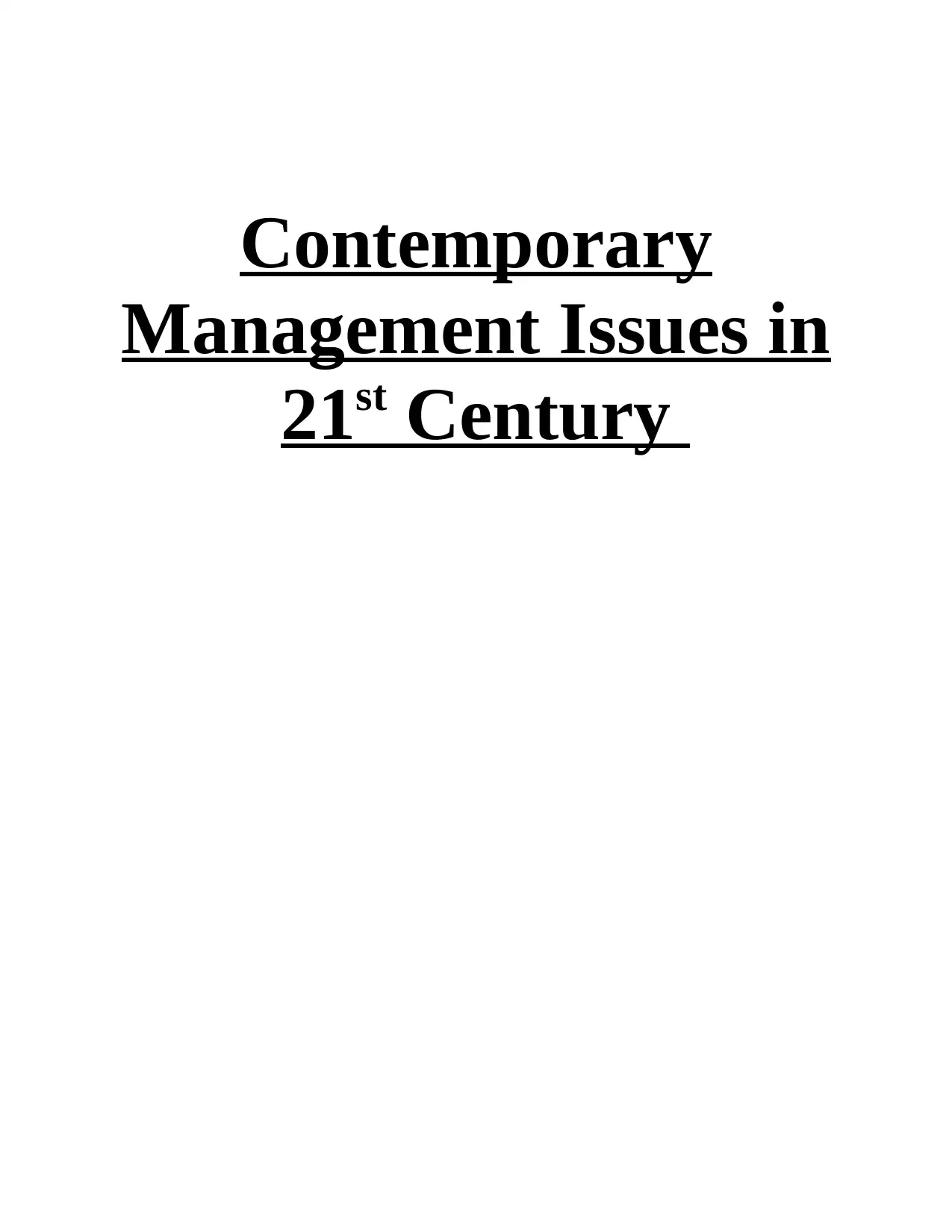
Contemporary
Management Issues in
21st Century
Management Issues in
21st Century
Paraphrase This Document
Need a fresh take? Get an instant paraphrase of this document with our AI Paraphraser
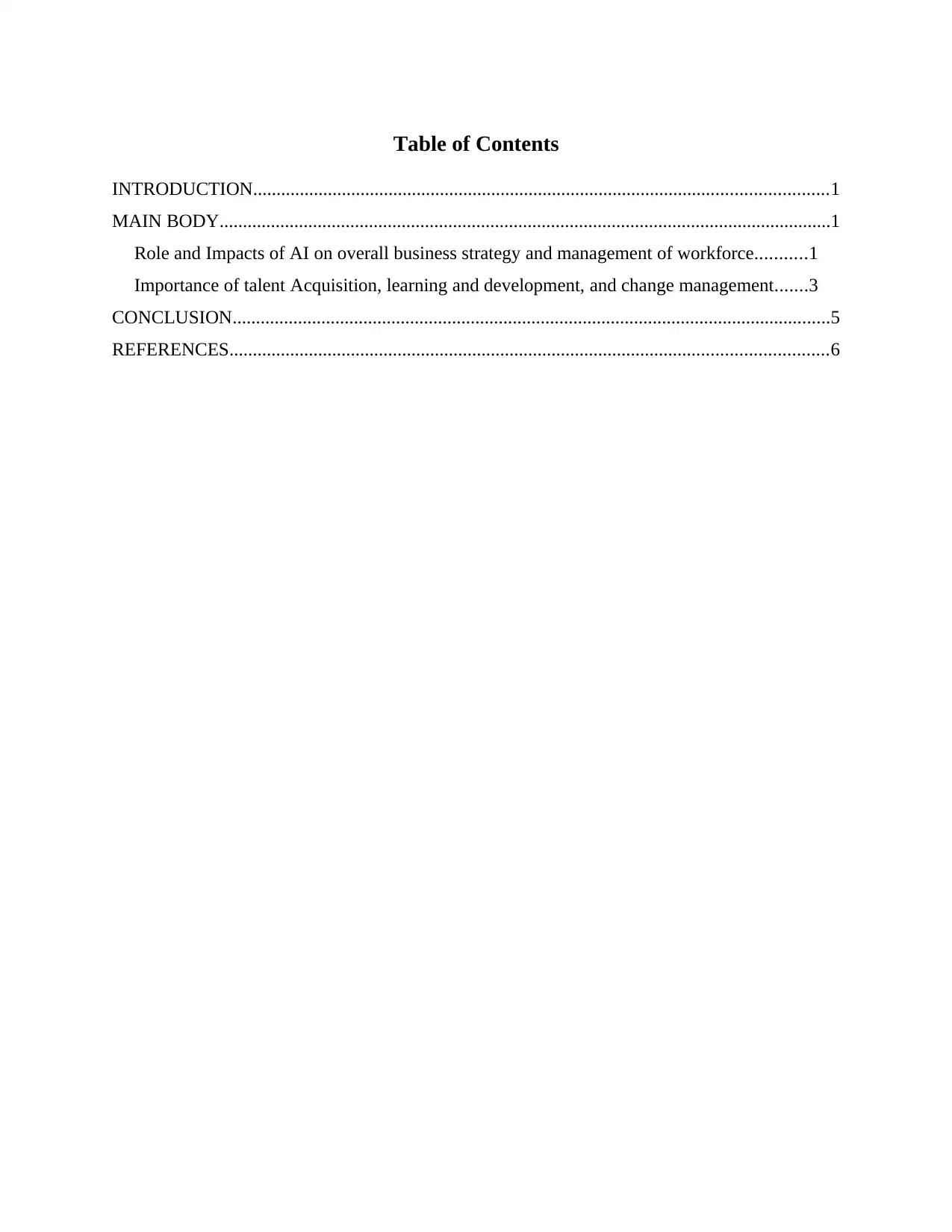
Table of Contents
INTRODUCTION...........................................................................................................................1
MAIN BODY...................................................................................................................................1
Role and Impacts of AI on overall business strategy and management of workforce...........1
Importance of talent Acquisition, learning and development, and change management.......3
CONCLUSION................................................................................................................................5
REFERENCES................................................................................................................................6
INTRODUCTION...........................................................................................................................1
MAIN BODY...................................................................................................................................1
Role and Impacts of AI on overall business strategy and management of workforce...........1
Importance of talent Acquisition, learning and development, and change management.......3
CONCLUSION................................................................................................................................5
REFERENCES................................................................................................................................6
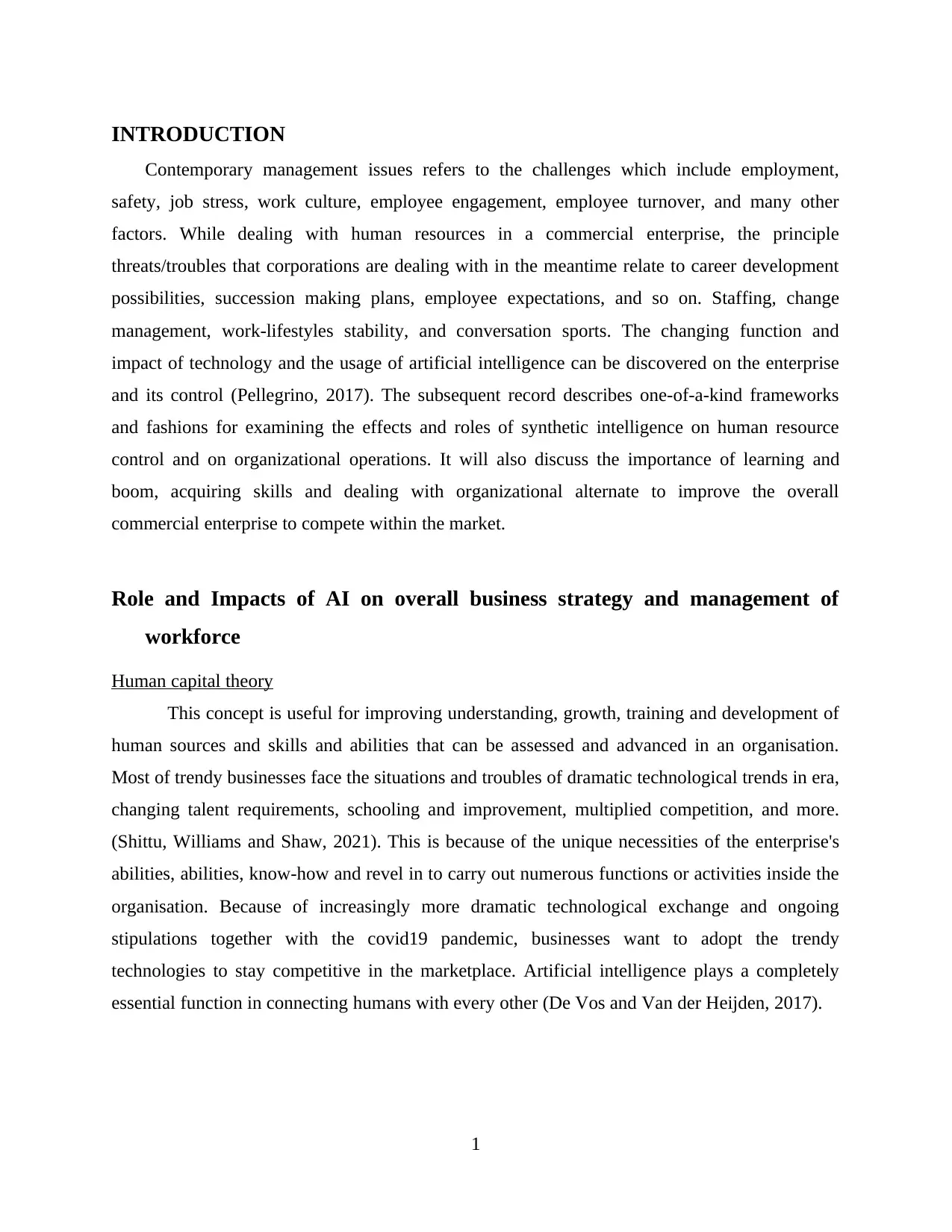
INTRODUCTION
Contemporary management issues refers to the challenges which include employment,
safety, job stress, work culture, employee engagement, employee turnover, and many other
factors. While dealing with human resources in a commercial enterprise, the principle
threats/troubles that corporations are dealing with in the meantime relate to career development
possibilities, succession making plans, employee expectations, and so on. Staffing, change
management, work-lifestyles stability, and conversation sports. The changing function and
impact of technology and the usage of artificial intelligence can be discovered on the enterprise
and its control (Pellegrino, 2017). The subsequent record describes one-of-a-kind frameworks
and fashions for examining the effects and roles of synthetic intelligence on human resource
control and on organizational operations. It will also discuss the importance of learning and
boom, acquiring skills and dealing with organizational alternate to improve the overall
commercial enterprise to compete within the market.
Role and Impacts of AI on overall business strategy and management of
workforce
Human capital theory
This concept is useful for improving understanding, growth, training and development of
human sources and skills and abilities that can be assessed and advanced in an organisation.
Most of trendy businesses face the situations and troubles of dramatic technological trends in era,
changing talent requirements, schooling and improvement, multiplied competition, and more.
(Shittu, Williams and Shaw, 2021). This is because of the unique necessities of the enterprise's
abilities, abilities, know-how and revel in to carry out numerous functions or activities inside the
organisation. Because of increasingly more dramatic technological exchange and ongoing
stipulations together with the covid19 pandemic, businesses want to adopt the trendy
technologies to stay competitive in the marketplace. Artificial intelligence plays a completely
essential function in connecting humans with every other (De Vos and Van der Heijden, 2017).
1
Contemporary management issues refers to the challenges which include employment,
safety, job stress, work culture, employee engagement, employee turnover, and many other
factors. While dealing with human resources in a commercial enterprise, the principle
threats/troubles that corporations are dealing with in the meantime relate to career development
possibilities, succession making plans, employee expectations, and so on. Staffing, change
management, work-lifestyles stability, and conversation sports. The changing function and
impact of technology and the usage of artificial intelligence can be discovered on the enterprise
and its control (Pellegrino, 2017). The subsequent record describes one-of-a-kind frameworks
and fashions for examining the effects and roles of synthetic intelligence on human resource
control and on organizational operations. It will also discuss the importance of learning and
boom, acquiring skills and dealing with organizational alternate to improve the overall
commercial enterprise to compete within the market.
Role and Impacts of AI on overall business strategy and management of
workforce
Human capital theory
This concept is useful for improving understanding, growth, training and development of
human sources and skills and abilities that can be assessed and advanced in an organisation.
Most of trendy businesses face the situations and troubles of dramatic technological trends in era,
changing talent requirements, schooling and improvement, multiplied competition, and more.
(Shittu, Williams and Shaw, 2021). This is because of the unique necessities of the enterprise's
abilities, abilities, know-how and revel in to carry out numerous functions or activities inside the
organisation. Because of increasingly more dramatic technological exchange and ongoing
stipulations together with the covid19 pandemic, businesses want to adopt the trendy
technologies to stay competitive in the marketplace. Artificial intelligence plays a completely
essential function in connecting humans with every other (De Vos and Van der Heijden, 2017).
1
⊘ This is a preview!⊘
Do you want full access?
Subscribe today to unlock all pages.

Trusted by 1+ million students worldwide
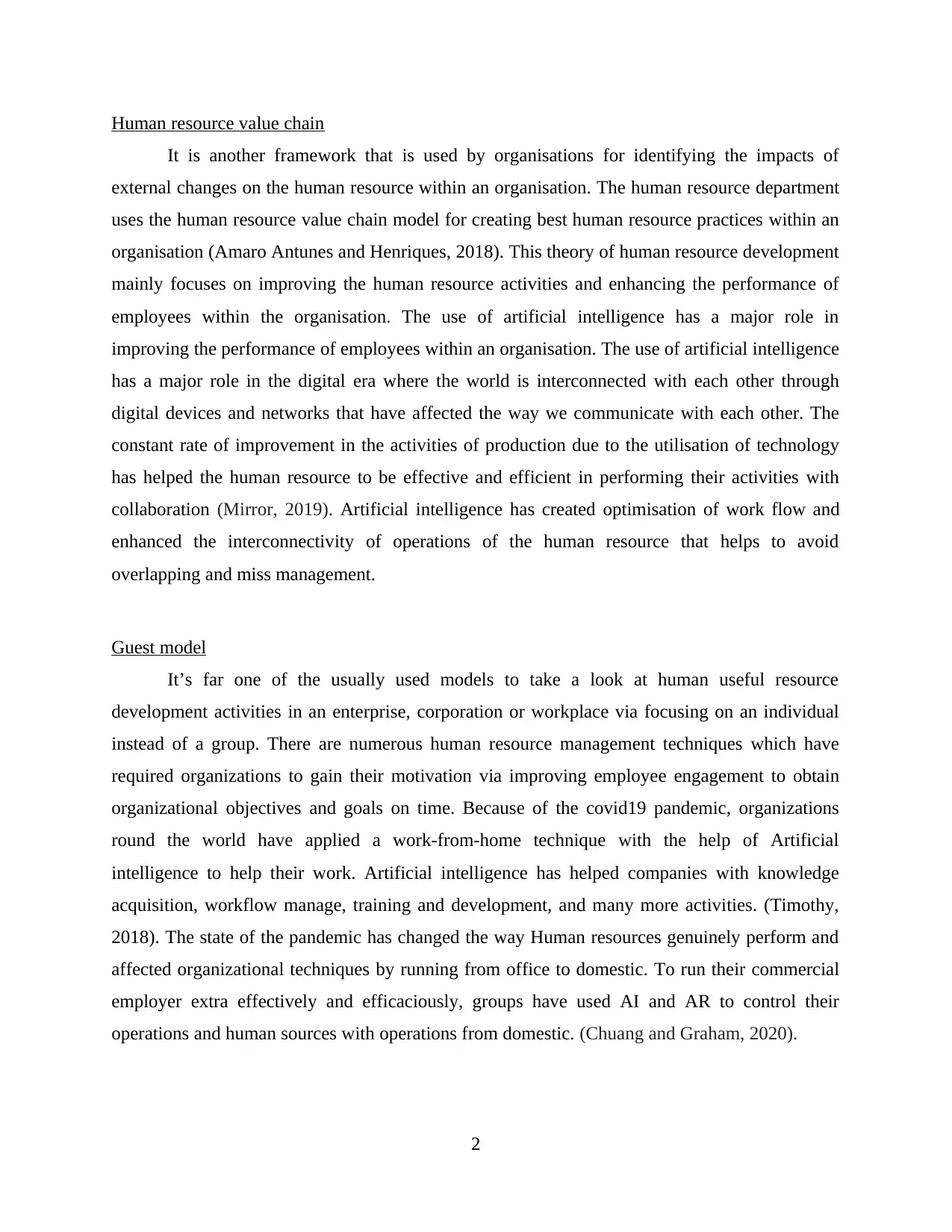
Human resource value chain
It is another framework that is used by organisations for identifying the impacts of
external changes on the human resource within an organisation. The human resource department
uses the human resource value chain model for creating best human resource practices within an
organisation (Amaro Antunes and Henriques, 2018). This theory of human resource development
mainly focuses on improving the human resource activities and enhancing the performance of
employees within the organisation. The use of artificial intelligence has a major role in
improving the performance of employees within an organisation. The use of artificial intelligence
has a major role in the digital era where the world is interconnected with each other through
digital devices and networks that have affected the way we communicate with each other. The
constant rate of improvement in the activities of production due to the utilisation of technology
has helped the human resource to be effective and efficient in performing their activities with
collaboration (Mirror, 2019). Artificial intelligence has created optimisation of work flow and
enhanced the interconnectivity of operations of the human resource that helps to avoid
overlapping and miss management.
Guest model
It’s far one of the usually used models to take a look at human useful resource
development activities in an enterprise, corporation or workplace via focusing on an individual
instead of a group. There are numerous human resource management techniques which have
required organizations to gain their motivation via improving employee engagement to obtain
organizational objectives and goals on time. Because of the covid19 pandemic, organizations
round the world have applied a work-from-home technique with the help of Artificial
intelligence to help their work. Artificial intelligence has helped companies with knowledge
acquisition, workflow manage, training and development, and many more activities. (Timothy,
2018). The state of the pandemic has changed the way Human resources genuinely perform and
affected organizational techniques by running from office to domestic. To run their commercial
employer extra effectively and efficaciously, groups have used AI and AR to control their
operations and human sources with operations from domestic. (Chuang and Graham, 2020).
2
It is another framework that is used by organisations for identifying the impacts of
external changes on the human resource within an organisation. The human resource department
uses the human resource value chain model for creating best human resource practices within an
organisation (Amaro Antunes and Henriques, 2018). This theory of human resource development
mainly focuses on improving the human resource activities and enhancing the performance of
employees within the organisation. The use of artificial intelligence has a major role in
improving the performance of employees within an organisation. The use of artificial intelligence
has a major role in the digital era where the world is interconnected with each other through
digital devices and networks that have affected the way we communicate with each other. The
constant rate of improvement in the activities of production due to the utilisation of technology
has helped the human resource to be effective and efficient in performing their activities with
collaboration (Mirror, 2019). Artificial intelligence has created optimisation of work flow and
enhanced the interconnectivity of operations of the human resource that helps to avoid
overlapping and miss management.
Guest model
It’s far one of the usually used models to take a look at human useful resource
development activities in an enterprise, corporation or workplace via focusing on an individual
instead of a group. There are numerous human resource management techniques which have
required organizations to gain their motivation via improving employee engagement to obtain
organizational objectives and goals on time. Because of the covid19 pandemic, organizations
round the world have applied a work-from-home technique with the help of Artificial
intelligence to help their work. Artificial intelligence has helped companies with knowledge
acquisition, workflow manage, training and development, and many more activities. (Timothy,
2018). The state of the pandemic has changed the way Human resources genuinely perform and
affected organizational techniques by running from office to domestic. To run their commercial
employer extra effectively and efficaciously, groups have used AI and AR to control their
operations and human sources with operations from domestic. (Chuang and Graham, 2020).
2
Paraphrase This Document
Need a fresh take? Get an instant paraphrase of this document with our AI Paraphraser
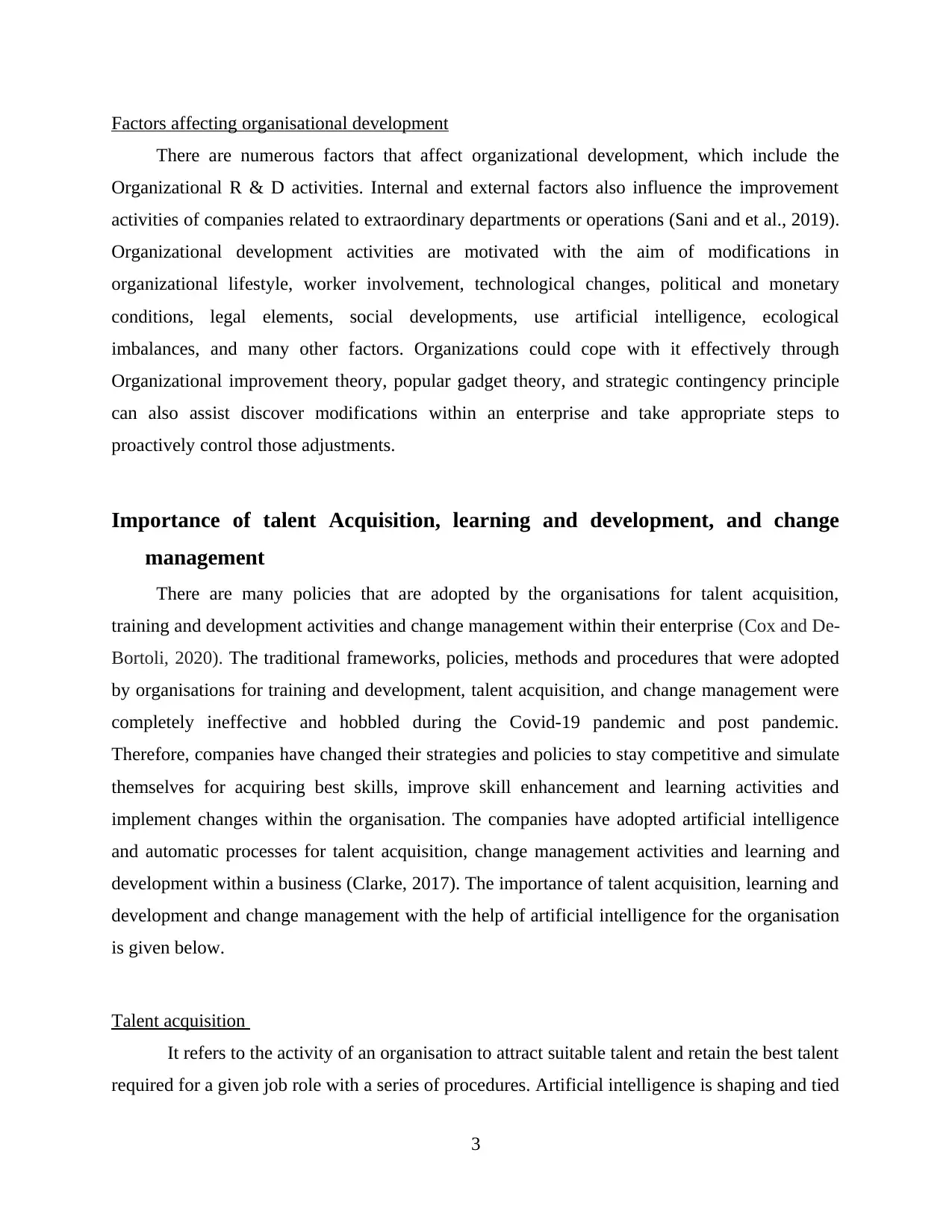
Factors affecting organisational development
There are numerous factors that affect organizational development, which include the
Organizational R & D activities. Internal and external factors also influence the improvement
activities of companies related to extraordinary departments or operations (Sani and et al., 2019).
Organizational development activities are motivated with the aim of modifications in
organizational lifestyle, worker involvement, technological changes, political and monetary
conditions, legal elements, social developments, use artificial intelligence, ecological
imbalances, and many other factors. Organizations could cope with it effectively through
Organizational improvement theory, popular gadget theory, and strategic contingency principle
can also assist discover modifications within an enterprise and take appropriate steps to
proactively control those adjustments.
Importance of talent Acquisition, learning and development, and change
management
There are many policies that are adopted by the organisations for talent acquisition,
training and development activities and change management within their enterprise (Cox and De-
Bortoli, 2020). The traditional frameworks, policies, methods and procedures that were adopted
by organisations for training and development, talent acquisition, and change management were
completely ineffective and hobbled during the Covid-19 pandemic and post pandemic.
Therefore, companies have changed their strategies and policies to stay competitive and simulate
themselves for acquiring best skills, improve skill enhancement and learning activities and
implement changes within the organisation. The companies have adopted artificial intelligence
and automatic processes for talent acquisition, change management activities and learning and
development within a business (Clarke, 2017). The importance of talent acquisition, learning and
development and change management with the help of artificial intelligence for the organisation
is given below.
Talent acquisition
It refers to the activity of an organisation to attract suitable talent and retain the best talent
required for a given job role with a series of procedures. Artificial intelligence is shaping and tied
3
There are numerous factors that affect organizational development, which include the
Organizational R & D activities. Internal and external factors also influence the improvement
activities of companies related to extraordinary departments or operations (Sani and et al., 2019).
Organizational development activities are motivated with the aim of modifications in
organizational lifestyle, worker involvement, technological changes, political and monetary
conditions, legal elements, social developments, use artificial intelligence, ecological
imbalances, and many other factors. Organizations could cope with it effectively through
Organizational improvement theory, popular gadget theory, and strategic contingency principle
can also assist discover modifications within an enterprise and take appropriate steps to
proactively control those adjustments.
Importance of talent Acquisition, learning and development, and change
management
There are many policies that are adopted by the organisations for talent acquisition,
training and development activities and change management within their enterprise (Cox and De-
Bortoli, 2020). The traditional frameworks, policies, methods and procedures that were adopted
by organisations for training and development, talent acquisition, and change management were
completely ineffective and hobbled during the Covid-19 pandemic and post pandemic.
Therefore, companies have changed their strategies and policies to stay competitive and simulate
themselves for acquiring best skills, improve skill enhancement and learning activities and
implement changes within the organisation. The companies have adopted artificial intelligence
and automatic processes for talent acquisition, change management activities and learning and
development within a business (Clarke, 2017). The importance of talent acquisition, learning and
development and change management with the help of artificial intelligence for the organisation
is given below.
Talent acquisition
It refers to the activity of an organisation to attract suitable talent and retain the best talent
required for a given job role with a series of procedures. Artificial intelligence is shaping and tied
3
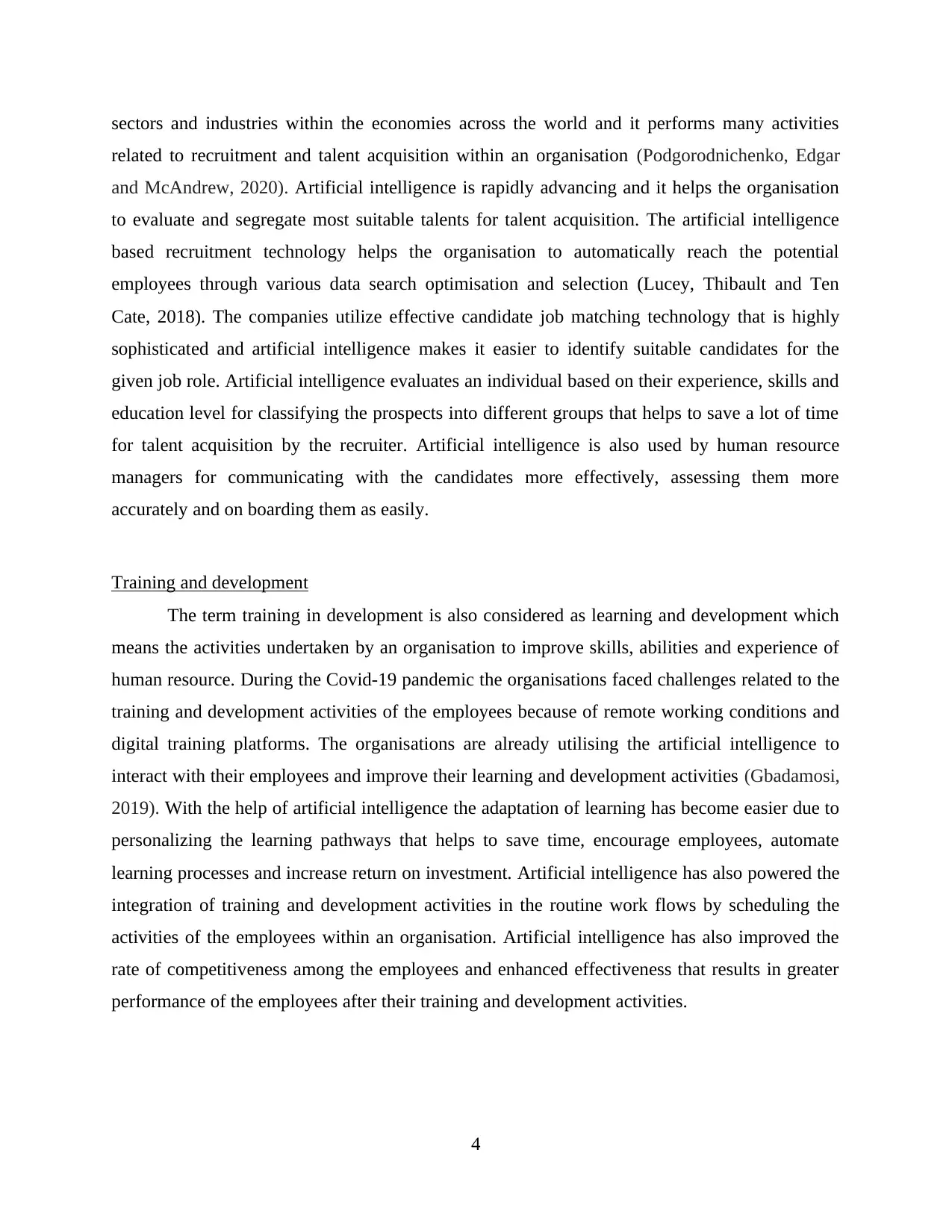
sectors and industries within the economies across the world and it performs many activities
related to recruitment and talent acquisition within an organisation (Podgorodnichenko, Edgar
and McAndrew, 2020). Artificial intelligence is rapidly advancing and it helps the organisation
to evaluate and segregate most suitable talents for talent acquisition. The artificial intelligence
based recruitment technology helps the organisation to automatically reach the potential
employees through various data search optimisation and selection (Lucey, Thibault and Ten
Cate, 2018). The companies utilize effective candidate job matching technology that is highly
sophisticated and artificial intelligence makes it easier to identify suitable candidates for the
given job role. Artificial intelligence evaluates an individual based on their experience, skills and
education level for classifying the prospects into different groups that helps to save a lot of time
for talent acquisition by the recruiter. Artificial intelligence is also used by human resource
managers for communicating with the candidates more effectively, assessing them more
accurately and on boarding them as easily.
Training and development
The term training in development is also considered as learning and development which
means the activities undertaken by an organisation to improve skills, abilities and experience of
human resource. During the Covid-19 pandemic the organisations faced challenges related to the
training and development activities of the employees because of remote working conditions and
digital training platforms. The organisations are already utilising the artificial intelligence to
interact with their employees and improve their learning and development activities (Gbadamosi,
2019). With the help of artificial intelligence the adaptation of learning has become easier due to
personalizing the learning pathways that helps to save time, encourage employees, automate
learning processes and increase return on investment. Artificial intelligence has also powered the
integration of training and development activities in the routine work flows by scheduling the
activities of the employees within an organisation. Artificial intelligence has also improved the
rate of competitiveness among the employees and enhanced effectiveness that results in greater
performance of the employees after their training and development activities.
4
related to recruitment and talent acquisition within an organisation (Podgorodnichenko, Edgar
and McAndrew, 2020). Artificial intelligence is rapidly advancing and it helps the organisation
to evaluate and segregate most suitable talents for talent acquisition. The artificial intelligence
based recruitment technology helps the organisation to automatically reach the potential
employees through various data search optimisation and selection (Lucey, Thibault and Ten
Cate, 2018). The companies utilize effective candidate job matching technology that is highly
sophisticated and artificial intelligence makes it easier to identify suitable candidates for the
given job role. Artificial intelligence evaluates an individual based on their experience, skills and
education level for classifying the prospects into different groups that helps to save a lot of time
for talent acquisition by the recruiter. Artificial intelligence is also used by human resource
managers for communicating with the candidates more effectively, assessing them more
accurately and on boarding them as easily.
Training and development
The term training in development is also considered as learning and development which
means the activities undertaken by an organisation to improve skills, abilities and experience of
human resource. During the Covid-19 pandemic the organisations faced challenges related to the
training and development activities of the employees because of remote working conditions and
digital training platforms. The organisations are already utilising the artificial intelligence to
interact with their employees and improve their learning and development activities (Gbadamosi,
2019). With the help of artificial intelligence the adaptation of learning has become easier due to
personalizing the learning pathways that helps to save time, encourage employees, automate
learning processes and increase return on investment. Artificial intelligence has also powered the
integration of training and development activities in the routine work flows by scheduling the
activities of the employees within an organisation. Artificial intelligence has also improved the
rate of competitiveness among the employees and enhanced effectiveness that results in greater
performance of the employees after their training and development activities.
4
⊘ This is a preview!⊘
Do you want full access?
Subscribe today to unlock all pages.

Trusted by 1+ million students worldwide
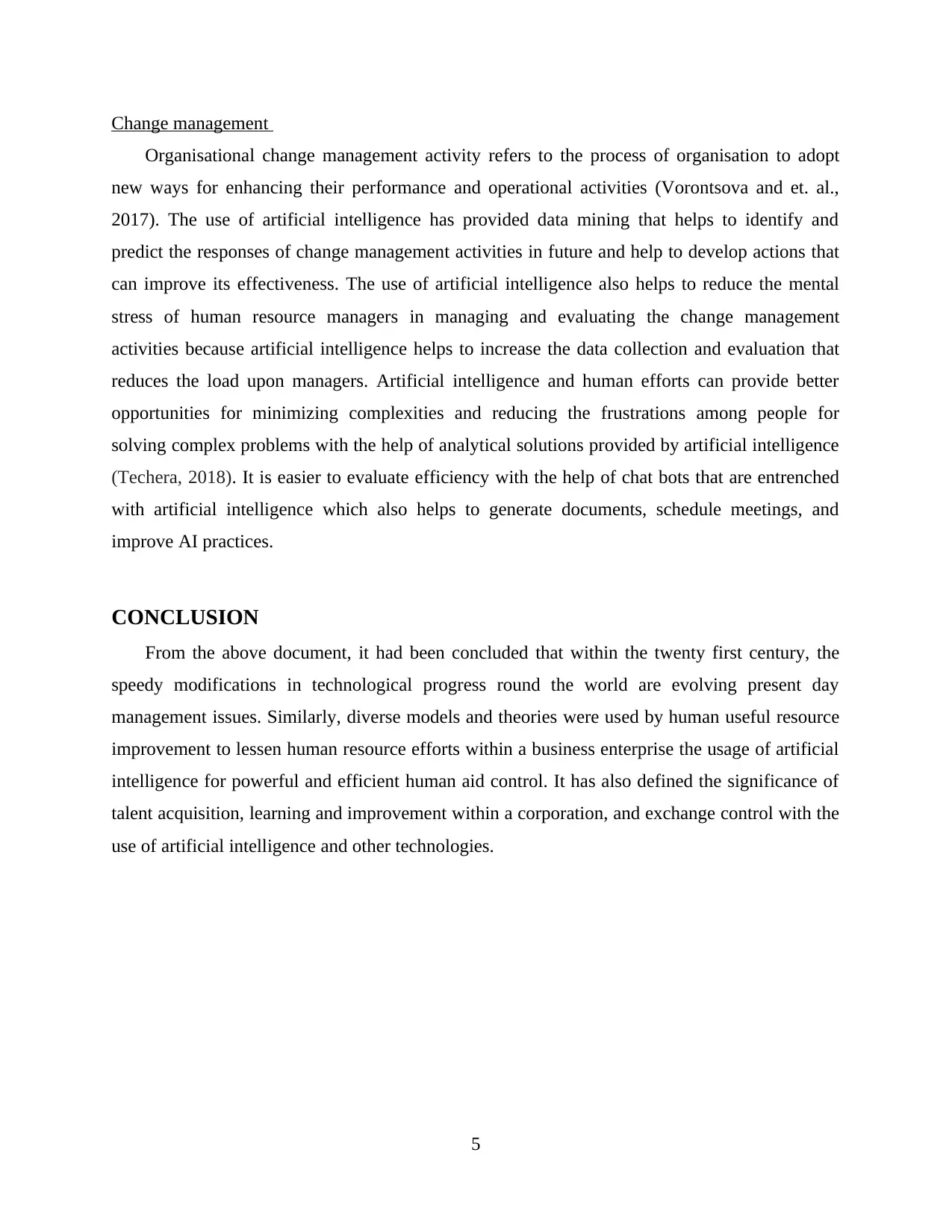
Change management
Organisational change management activity refers to the process of organisation to adopt
new ways for enhancing their performance and operational activities (Vorontsova and et. al.,
2017). The use of artificial intelligence has provided data mining that helps to identify and
predict the responses of change management activities in future and help to develop actions that
can improve its effectiveness. The use of artificial intelligence also helps to reduce the mental
stress of human resource managers in managing and evaluating the change management
activities because artificial intelligence helps to increase the data collection and evaluation that
reduces the load upon managers. Artificial intelligence and human efforts can provide better
opportunities for minimizing complexities and reducing the frustrations among people for
solving complex problems with the help of analytical solutions provided by artificial intelligence
(Techera, 2018). It is easier to evaluate efficiency with the help of chat bots that are entrenched
with artificial intelligence which also helps to generate documents, schedule meetings, and
improve AI practices.
CONCLUSION
From the above document, it had been concluded that within the twenty first century, the
speedy modifications in technological progress round the world are evolving present day
management issues. Similarly, diverse models and theories were used by human useful resource
improvement to lessen human resource efforts within a business enterprise the usage of artificial
intelligence for powerful and efficient human aid control. It has also defined the significance of
talent acquisition, learning and improvement within a corporation, and exchange control with the
use of artificial intelligence and other technologies.
5
Organisational change management activity refers to the process of organisation to adopt
new ways for enhancing their performance and operational activities (Vorontsova and et. al.,
2017). The use of artificial intelligence has provided data mining that helps to identify and
predict the responses of change management activities in future and help to develop actions that
can improve its effectiveness. The use of artificial intelligence also helps to reduce the mental
stress of human resource managers in managing and evaluating the change management
activities because artificial intelligence helps to increase the data collection and evaluation that
reduces the load upon managers. Artificial intelligence and human efforts can provide better
opportunities for minimizing complexities and reducing the frustrations among people for
solving complex problems with the help of analytical solutions provided by artificial intelligence
(Techera, 2018). It is easier to evaluate efficiency with the help of chat bots that are entrenched
with artificial intelligence which also helps to generate documents, schedule meetings, and
improve AI practices.
CONCLUSION
From the above document, it had been concluded that within the twenty first century, the
speedy modifications in technological progress round the world are evolving present day
management issues. Similarly, diverse models and theories were used by human useful resource
improvement to lessen human resource efforts within a business enterprise the usage of artificial
intelligence for powerful and efficient human aid control. It has also defined the significance of
talent acquisition, learning and improvement within a corporation, and exchange control with the
use of artificial intelligence and other technologies.
5
Paraphrase This Document
Need a fresh take? Get an instant paraphrase of this document with our AI Paraphraser
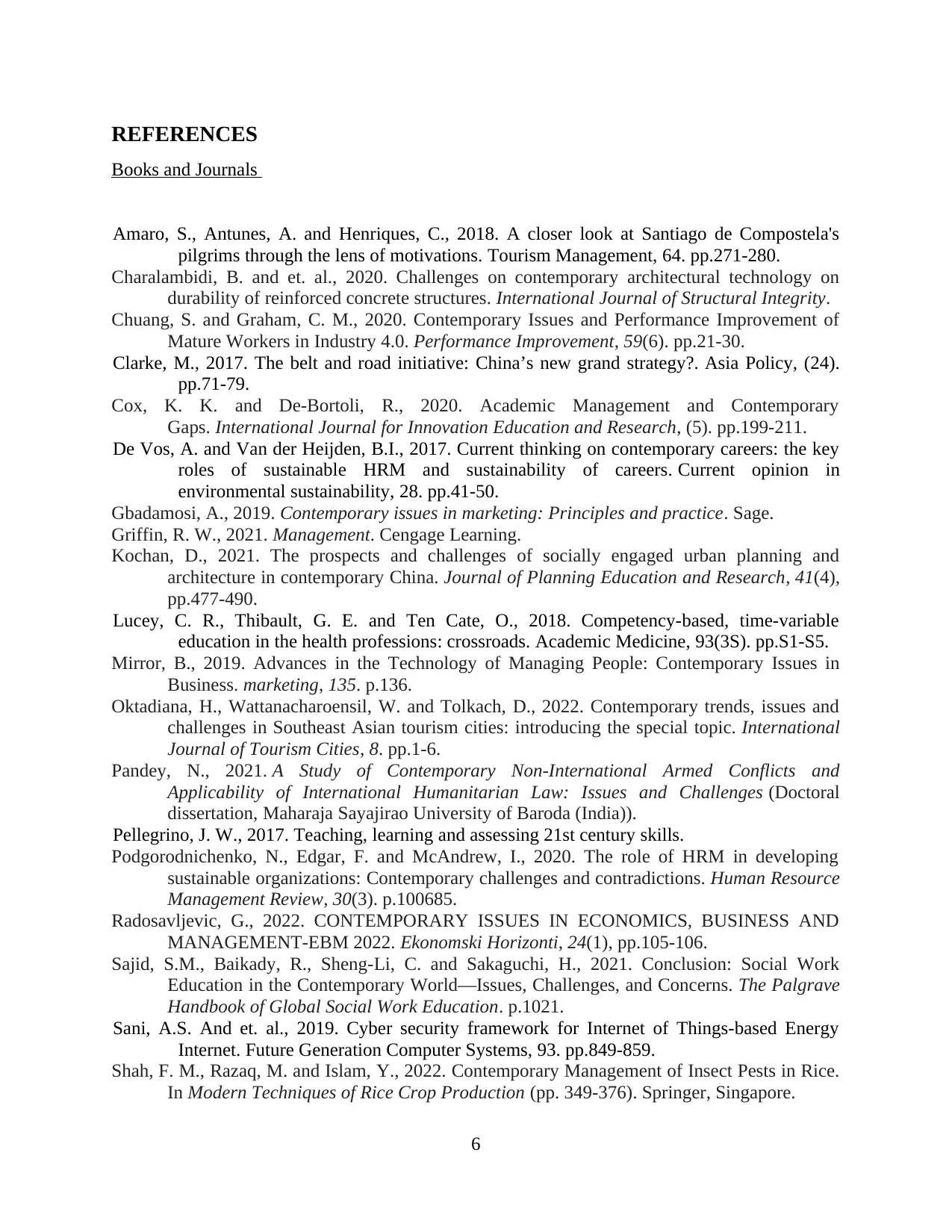
REFERENCES
Books and Journals
Amaro, S., Antunes, A. and Henriques, C., 2018. A closer look at Santiago de Compostela's
pilgrims through the lens of motivations. Tourism Management, 64. pp.271-280.
Charalambidi, B. and et. al., 2020. Challenges on contemporary architectural technology on
durability of reinforced concrete structures. International Journal of Structural Integrity.
Chuang, S. and Graham, C. M., 2020. Contemporary Issues and Performance Improvement of
Mature Workers in Industry 4.0. Performance Improvement, 59(6). pp.21-30.
Clarke, M., 2017. The belt and road initiative: China’s new grand strategy?. Asia Policy, (24).
pp.71-79.
Cox, K. K. and De-Bortoli, R., 2020. Academic Management and Contemporary
Gaps. International Journal for Innovation Education and Research, (5). pp.199-211.
De Vos, A. and Van der Heijden, B.I., 2017. Current thinking on contemporary careers: the key
roles of sustainable HRM and sustainability of careers. Current opinion in
environmental sustainability, 28. pp.41-50.
Gbadamosi, A., 2019. Contemporary issues in marketing: Principles and practice. Sage.
Griffin, R. W., 2021. Management. Cengage Learning.
Kochan, D., 2021. The prospects and challenges of socially engaged urban planning and
architecture in contemporary China. Journal of Planning Education and Research, 41(4),
pp.477-490.
Lucey, C. R., Thibault, G. E. and Ten Cate, O., 2018. Competency-based, time-variable
education in the health professions: crossroads. Academic Medicine, 93(3S). pp.S1-S5.
Mirror, B., 2019. Advances in the Technology of Managing People: Contemporary Issues in
Business. marketing, 135. p.136.
Oktadiana, H., Wattanacharoensil, W. and Tolkach, D., 2022. Contemporary trends, issues and
challenges in Southeast Asian tourism cities: introducing the special topic. International
Journal of Tourism Cities, 8. pp.1-6.
Pandey, N., 2021. A Study of Contemporary Non-International Armed Conflicts and
Applicability of International Humanitarian Law: Issues and Challenges (Doctoral
dissertation, Maharaja Sayajirao University of Baroda (India)).
Pellegrino, J. W., 2017. Teaching, learning and assessing 21st century skills.
Podgorodnichenko, N., Edgar, F. and McAndrew, I., 2020. The role of HRM in developing
sustainable organizations: Contemporary challenges and contradictions. Human Resource
Management Review, 30(3). p.100685.
Radosavljevic, G., 2022. CONTEMPORARY ISSUES IN ECONOMICS, BUSINESS AND
MANAGEMENT-EBM 2022. Ekonomski Horizonti, 24(1), pp.105-106.
Sajid, S.M., Baikady, R., Sheng-Li, C. and Sakaguchi, H., 2021. Conclusion: Social Work
Education in the Contemporary World—Issues, Challenges, and Concerns. The Palgrave
Handbook of Global Social Work Education. p.1021.
Sani, A.S. And et. al., 2019. Cyber security framework for Internet of Things-based Energy
Internet. Future Generation Computer Systems, 93. pp.849-859.
Shah, F. M., Razaq, M. and Islam, Y., 2022. Contemporary Management of Insect Pests in Rice.
In Modern Techniques of Rice Crop Production (pp. 349-376). Springer, Singapore.
6
Books and Journals
Amaro, S., Antunes, A. and Henriques, C., 2018. A closer look at Santiago de Compostela's
pilgrims through the lens of motivations. Tourism Management, 64. pp.271-280.
Charalambidi, B. and et. al., 2020. Challenges on contemporary architectural technology on
durability of reinforced concrete structures. International Journal of Structural Integrity.
Chuang, S. and Graham, C. M., 2020. Contemporary Issues and Performance Improvement of
Mature Workers in Industry 4.0. Performance Improvement, 59(6). pp.21-30.
Clarke, M., 2017. The belt and road initiative: China’s new grand strategy?. Asia Policy, (24).
pp.71-79.
Cox, K. K. and De-Bortoli, R., 2020. Academic Management and Contemporary
Gaps. International Journal for Innovation Education and Research, (5). pp.199-211.
De Vos, A. and Van der Heijden, B.I., 2017. Current thinking on contemporary careers: the key
roles of sustainable HRM and sustainability of careers. Current opinion in
environmental sustainability, 28. pp.41-50.
Gbadamosi, A., 2019. Contemporary issues in marketing: Principles and practice. Sage.
Griffin, R. W., 2021. Management. Cengage Learning.
Kochan, D., 2021. The prospects and challenges of socially engaged urban planning and
architecture in contemporary China. Journal of Planning Education and Research, 41(4),
pp.477-490.
Lucey, C. R., Thibault, G. E. and Ten Cate, O., 2018. Competency-based, time-variable
education in the health professions: crossroads. Academic Medicine, 93(3S). pp.S1-S5.
Mirror, B., 2019. Advances in the Technology of Managing People: Contemporary Issues in
Business. marketing, 135. p.136.
Oktadiana, H., Wattanacharoensil, W. and Tolkach, D., 2022. Contemporary trends, issues and
challenges in Southeast Asian tourism cities: introducing the special topic. International
Journal of Tourism Cities, 8. pp.1-6.
Pandey, N., 2021. A Study of Contemporary Non-International Armed Conflicts and
Applicability of International Humanitarian Law: Issues and Challenges (Doctoral
dissertation, Maharaja Sayajirao University of Baroda (India)).
Pellegrino, J. W., 2017. Teaching, learning and assessing 21st century skills.
Podgorodnichenko, N., Edgar, F. and McAndrew, I., 2020. The role of HRM in developing
sustainable organizations: Contemporary challenges and contradictions. Human Resource
Management Review, 30(3). p.100685.
Radosavljevic, G., 2022. CONTEMPORARY ISSUES IN ECONOMICS, BUSINESS AND
MANAGEMENT-EBM 2022. Ekonomski Horizonti, 24(1), pp.105-106.
Sajid, S.M., Baikady, R., Sheng-Li, C. and Sakaguchi, H., 2021. Conclusion: Social Work
Education in the Contemporary World—Issues, Challenges, and Concerns. The Palgrave
Handbook of Global Social Work Education. p.1021.
Sani, A.S. And et. al., 2019. Cyber security framework for Internet of Things-based Energy
Internet. Future Generation Computer Systems, 93. pp.849-859.
Shah, F. M., Razaq, M. and Islam, Y., 2022. Contemporary Management of Insect Pests in Rice.
In Modern Techniques of Rice Crop Production (pp. 349-376). Springer, Singapore.
6
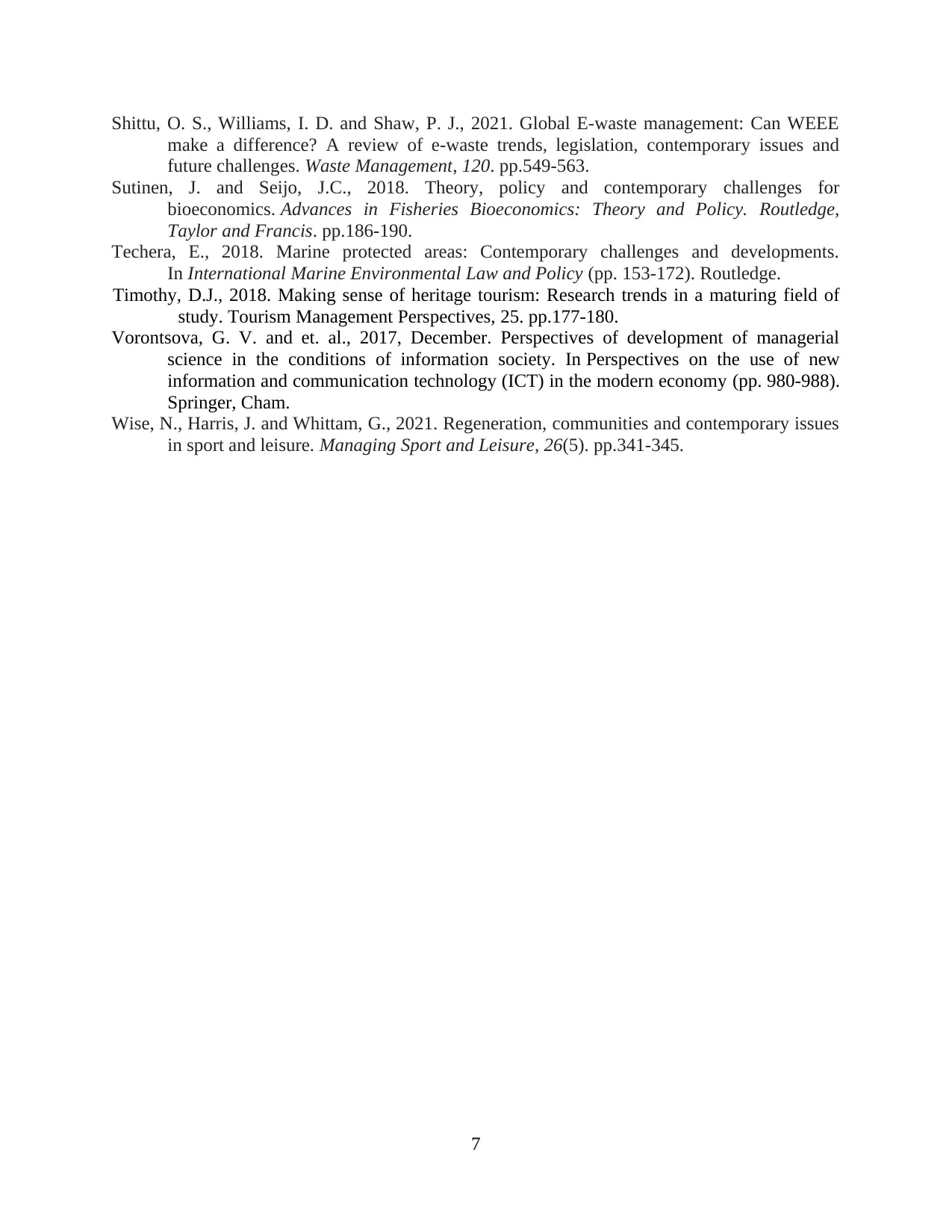
Shittu, O. S., Williams, I. D. and Shaw, P. J., 2021. Global E-waste management: Can WEEE
make a difference? A review of e-waste trends, legislation, contemporary issues and
future challenges. Waste Management, 120. pp.549-563.
Sutinen, J. and Seijo, J.C., 2018. Theory, policy and contemporary challenges for
bioeconomics. Advances in Fisheries Bioeconomics: Theory and Policy. Routledge,
Taylor and Francis. pp.186-190.
Techera, E., 2018. Marine protected areas: Contemporary challenges and developments.
In International Marine Environmental Law and Policy (pp. 153-172). Routledge.
Timothy, D.J., 2018. Making sense of heritage tourism: Research trends in a maturing field of
study. Tourism Management Perspectives, 25. pp.177-180.
Vorontsova, G. V. and et. al., 2017, December. Perspectives of development of managerial
science in the conditions of information society. In Perspectives on the use of new
information and communication technology (ICT) in the modern economy (pp. 980-988).
Springer, Cham.
Wise, N., Harris, J. and Whittam, G., 2021. Regeneration, communities and contemporary issues
in sport and leisure. Managing Sport and Leisure, 26(5). pp.341-345.
7
make a difference? A review of e-waste trends, legislation, contemporary issues and
future challenges. Waste Management, 120. pp.549-563.
Sutinen, J. and Seijo, J.C., 2018. Theory, policy and contemporary challenges for
bioeconomics. Advances in Fisheries Bioeconomics: Theory and Policy. Routledge,
Taylor and Francis. pp.186-190.
Techera, E., 2018. Marine protected areas: Contemporary challenges and developments.
In International Marine Environmental Law and Policy (pp. 153-172). Routledge.
Timothy, D.J., 2018. Making sense of heritage tourism: Research trends in a maturing field of
study. Tourism Management Perspectives, 25. pp.177-180.
Vorontsova, G. V. and et. al., 2017, December. Perspectives of development of managerial
science in the conditions of information society. In Perspectives on the use of new
information and communication technology (ICT) in the modern economy (pp. 980-988).
Springer, Cham.
Wise, N., Harris, J. and Whittam, G., 2021. Regeneration, communities and contemporary issues
in sport and leisure. Managing Sport and Leisure, 26(5). pp.341-345.
7
⊘ This is a preview!⊘
Do you want full access?
Subscribe today to unlock all pages.

Trusted by 1+ million students worldwide
1 out of 9
Related Documents
Your All-in-One AI-Powered Toolkit for Academic Success.
+13062052269
info@desklib.com
Available 24*7 on WhatsApp / Email
![[object Object]](/_next/static/media/star-bottom.7253800d.svg)
Unlock your academic potential
Copyright © 2020–2025 A2Z Services. All Rights Reserved. Developed and managed by ZUCOL.


